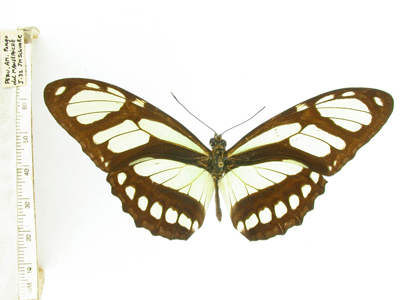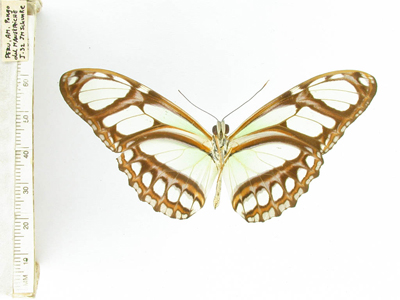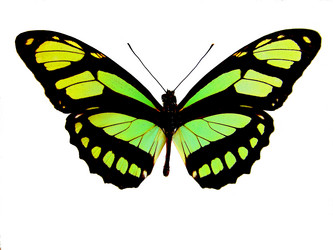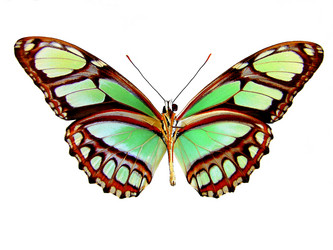Philaethria dido
Margarita Beltrán and Andrew V. Z. BrowerIntroduction
A widespread neotropical species. The butterflies are rapid fliers that prefer to spend their time in the forest canopy, but may be encountered in sunny areas where trees have fallen. Note that fresh specimens exhibit a bright lime-green color on both surfaces of the wings, but that this fades in museum specimens, such as those illustrated above. Like all members of Heliconiina, Philaethria dido larvae feed on various Passiflora species (see Habits), but unlike many Heliconius, appear to specialize on older leaves (DeVries, 1987).Characteristics
Early Stages: Eggs are yellow and approximately 1.5 x 1.2 mm (h x w). Females usually place eggs singly under older leaves of the host plant. Mature larvae have a white body with black and red stripes, with black, white and red scoli and yellow head; length is around 2.3 cm. Caterpillars are gregarious in small numbers (Brown, 1981).
Habits
Philaethria dido occurs in dense forests. Usually individuals fly rapidly in the canopy. Adults roost solitarily at night under leaves (Brown, 1981).
Hostplant: Philaethria dido larvae feed primarily on plants from the subgenera Astropea, Distephana and Granadilla (Passifloraceae)(Brown, 1981). In Costa Rica larvae feed on Passiflora vitifolia, P. edulis and P. ambigua (Passifloraceae) (DeVries, 1987).
Geographical races/subspecies
- Philaethria dido dido (Linnaeus, 1763) is widespread in Central and tropical South America.
- Philaethria dido chocoensis Constantino, 1999 is endemic to the Chocó region of northwestern Colombia.
References
Brown K. S. 1981 The Biology of Heliconius and Related Genera. Annual Review of Entomology 26, 427-456.
Constantino, L. M. 1999 Nuevas especies y subespecies y un nuevo g?nero de Ropaloceros del occidente de Colombia (Lepidoptera: Papilionidae, Nymphalidae, Charaxinae, Ithomiinae, Heliconiinae). Bolet?n Cient?fico Museo de Historia Natural, Manizales, Colombia 3: 57-68.
DeVries P. J. 1987 The Butterflies of Costa Rica and Their Natural History, Volume I: Papilionidae, Pieridae, Nymphalidae Princeton University Press, Baskerville, USA.
Linnaeus C. 1763 Centuria insectorum rariorum. Upsala. [vi] + 32 pp.
Title Illustrations

| Scientific Name | Philaethria dido |
|---|---|
| Specimen Condition | Dead Specimen |
| View | dorsal |
| Collection | Gerardo Lamas |
| Image Use |
 This media file is licensed under the Creative Commons Attribution-NonCommercial-ShareAlike License - Version 3.0. This media file is licensed under the Creative Commons Attribution-NonCommercial-ShareAlike License - Version 3.0.
|
| Copyright |
©

|
| Scientific Name | Philaethria dido |
|---|---|
| Specimen Condition | Dead Specimen |
| View | ventral |
| Collection | Gerardo Lamas |
| Image Use |
 This media file is licensed under the Creative Commons Attribution-NonCommercial-ShareAlike License - Version 3.0. This media file is licensed under the Creative Commons Attribution-NonCommercial-ShareAlike License - Version 3.0.
|
| Copyright |
©

|
About This Page

University of Cambridge, Cambridge, UK

Middle Tennessee State University, Murfreesboro, Tennessee, USA
Correspondence regarding this page should be directed to Margarita Beltr?n at and Andrew V. Z. Brower at
Page copyright © 2010 and
 Page: Tree of Life
Philaethria dido .
Authored by
Margarita Beltr?n and Andrew V. Z. Brower.
The TEXT of this page is licensed under the
Creative Commons Attribution-NonCommercial-ShareAlike License - Version 3.0. Note that images and other media
featured on this page are each governed by their own license, and they may or may not be available
for reuse. Click on an image or a media link to access the media data window, which provides the
relevant licensing information. For the general terms and conditions of ToL material reuse and
redistribution, please see the Tree of Life Copyright
Policies.
Page: Tree of Life
Philaethria dido .
Authored by
Margarita Beltr?n and Andrew V. Z. Brower.
The TEXT of this page is licensed under the
Creative Commons Attribution-NonCommercial-ShareAlike License - Version 3.0. Note that images and other media
featured on this page are each governed by their own license, and they may or may not be available
for reuse. Click on an image or a media link to access the media data window, which provides the
relevant licensing information. For the general terms and conditions of ToL material reuse and
redistribution, please see the Tree of Life Copyright
Policies.
- First online 21 February 2007
- Content changed 25 August 2010
Citing this page:
Beltrán, Margarita and Andrew V. Z. Brower. 2010. Philaethria dido . Version 25 August 2010 (under construction). http://tolweb.org/Philaethria_dido/72873/2010.08.25 in The Tree of Life Web Project, http://tolweb.org/












 Go to quick links
Go to quick search
Go to navigation for this section of the ToL site
Go to detailed links for the ToL site
Go to quick links
Go to quick search
Go to navigation for this section of the ToL site
Go to detailed links for the ToL site